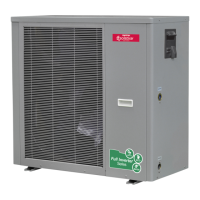– 14 –
SIM Inverter Monobloc Air-to-Water Heat Pump
Glycol/Water System Design
Each SIM heat pump has a recommended ow that should be
maintained during all times of operation. For the SIM-060, the
recommended ow is 13GPM at which the head loss is 23ft W.C,
10PSI or 69kPa. For the SIM-036 the recommended water ow is
7GPM at which the head loss is 13.8 ft W.C., 6 PSI, or 41.3 kPa.
These head loss values are based upon pure water, see Table 1
for multipliers to correct for various concentrations of anti-freeze
solution. Head loss values shown are for the heat pump only,
the selected circulator must be capable of overcoming the entire
system head loss.
Note: these are the recommended ow values. Should the ow
drop signicantly below this value, the heat pump will shut down.
This is not an indication of a fault in the heat pump, but rather
points to insufcient pump or plumbing capacity, or air trapped
within the system.
Glycol/Water Mixture
Automotive glycol is not suitable for use in the SIM
system. Over time it may leave deposits which will
degrade the performance and damage pumps or
other devices in the system. Use only ethylene
glycol or propylene glycol mixtures specically
labeled for boiler or HVAC use.
Obtain all components specied in the Typical System Diagram.
Make sure all components and piping comply with applicable
local codes.
DO NOT use galvanized pipe anywhere in the system.
Galvanizing will react with the glycol and can cause glycol
degradation and sludge in the system.
• Conrm charge of expansion tank is 12-15 PSIG (with no
water or pressure in the system).
• Install the system piping. DO NOT connect the heat pump
unit to the system piping until the system has been cleaned
as required below.
The SIM must NOT be connected to the system during this
process.
1. Connect a hose from a fresh water supply to the system ll
hose bib. Note the drain port can be used for this purpose.
The hose bib purge/drain valve should be located low in the
system and close to the SIM return connection.
2. Open the high point purge valve, (not shown in illustration, as
it may be inside the air handler) while slowly lling the system.
Close the valve when air is removed from the system and water
begins to ow out of the valve.
3. Fill the system with fresh water and run water until the system
has been thoroughly ushed clean.
Automatic Fill – When an automatic ll system is installed, the
cooling uid (Glycol/water) must be inspected at least every 3
months, or whenever a leak is detected to ensure the proper
glycol concentration is maintained.
System Volume and Expansion Volume
To ensure smooth temperature control and minimize cycling of
refrigeration system, all installations must have total circulating
volumes equal to or greater than 7.5 gallons per nominal ton of
the unit performance at minimum capacity (The greater of either
heating or cooling produced). In other words, in the case of a
ve ton heat pump with 3 to 1 turndown (0.33x rated capacity)
the minimum total system volume is 5x0.33x7.5=12.5 gal.
Multiple heat pump installations that are operating in a staged
conguration follow the same rule, so that only a single heat
pump tonnage needs to be considered. Additionally, the system
requires an expansion volume (air) to compensate for the change
in volume of the glycol mixture as it heats and cools, see Table
1 for expansion volume. A typical multiple heat pump installation
may actually have a volume far greater than the minimum
required, and it is this entire volume that must be considered
when sizing the expansion tank. Note that the nominal expansion
tank volume is not the same as the expansion volume. If the
actual air volume is not published, consider it to be no more than
half the nominal volume. As an example, a ve ton nominal heat
pump operating down to 33% capacity, used for both heating
and cooling, requires a minimum of 12.5 gallons of circulated
system volume. A 13 gallon buffer tank is selected for best
operation. When the system installation is complete, the total
volume including the heat pump, buffer tank, and all plumbing
is 18 gallons. (Note: the expansion tank, no matter how large, is
not considered circulated volume). According to the chart above,
the minimum acceptance volume of the expansion tank must
be at least 18/15, or 1.2 gallons. If the acceptance volume is
not specied, assume it is no greater than 50% of the total tank
volume. Therefore in the case of this example, the system would
require a minimum tank size of 2.4 gallons. As it is unlikely to
nd this specic size. Always be sure to round up, so a tank of 3
gallons total volume, or larger, would be appropriate.
Air Separator
Locate at least one high efciency air separator as shown in the
piping to remove any air from the system.
Pressure Test The System
1. Add water to the system as needed to raise the pressure to
25 PSIG (verify that all system components are suitable for
this pressure). Verify that the pressure remains constant for
at least one hour. Locate and correct any leaks.
2. After successfully testing, drain the system and remove the
fresh water hose.
Insulate The Piping
For systems used in cooling applications, the plumbing should be
insulated using a vapor barrier to prevent sweating of the pipes
and possible damage of the insulation or structure due to water
accumulation.

